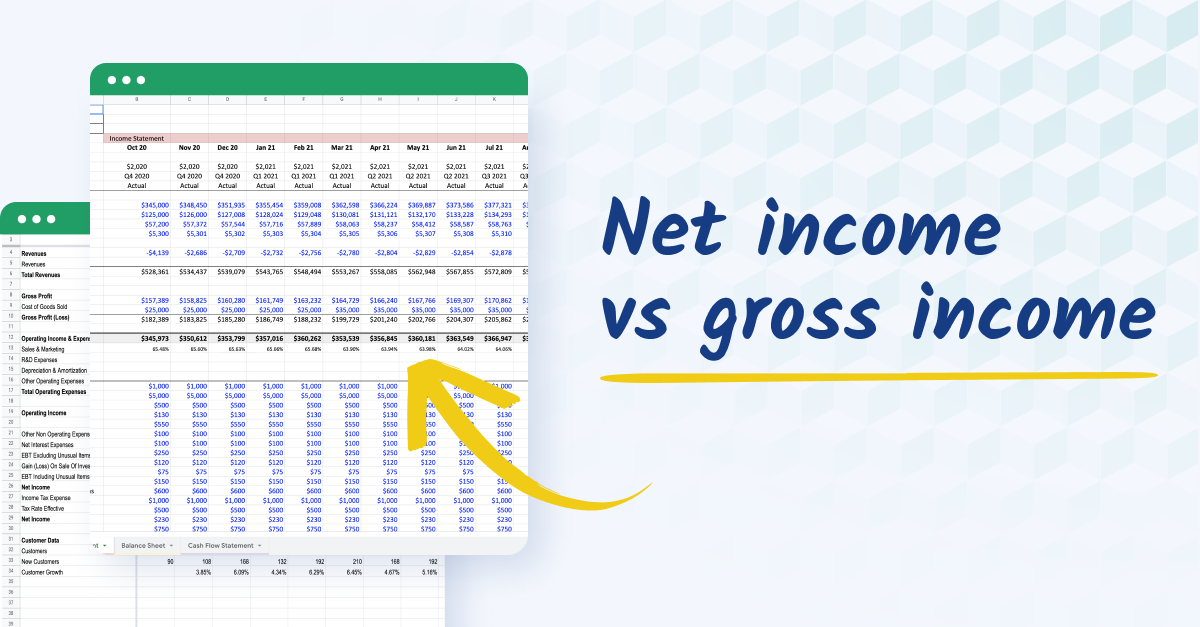Defining gross income
Gross income is the total amount earned before deductions, such as taxes, employee withholdings, benefits, loan payments, and other obligations. It includes all sources of revenue, from sales, interest, and investments, and is often seen as the starting point for calculating available liquid cash.
Note: Gross income does not include the cost of goods sold (COGS) for producing products or services. These are calculated as part of the gross income calculation—before other expenses are subtracted—to calculate net vs. gross income.
Gross income can be found at the top of the company’s profit and loss statement. It covers all a company’s revenue sources, such as sales, interest on investments, and rental income. Gross income is a snapshot of the company's financial health by indicating its earnings before subtracting costs like overheads, salaries, taxes, and other operational expenses.
The gross income figure provides a comprehensive view of the company's financial robustness, serving as the initial measure of profitability and operational efficiency. It allows analysts to gauge revenue-generating capabilities before accounting for costs and expenses. This provides valuable insight into potential areas of cost management.
In forecasting activities, gross income helps predict future cash flows and profitability trends, aiding investment decisions and strategic planning. For these reasons, gross income is the foundation for further financial assessments.

Net income explained
Companies need services, goods, materials, and support to bring in income. Those expenses figure into the net earnings and the bottom line. Net income is what remains of gross revenue after deductions have been made. Essentially, net income represents the earnings retained after fulfilling the company’s financial obligations.
Define the costs deducted from gross income to arrive at net income
Net income gives a more accurate picture of financial health, reflecting the actual cash value available for reinvestment, savings, profit sharing, or other corporate activities.
Several cost categories get deducted from gross income to arrive at net income, including:
- Operating expenses: These expenses cover purchases and fees to keep the company running, such as salaries, utilities, rent, research & development costs, and marketing expenses. These are the daily costs a business incurs outside of direct production costs or returns.
- Interest and tax expenses: Costs accrued from borrowing money or issuing bonds get subtracted from gross income. Similarly, taxes imposed by local and federal governments form another significant deduction.
- One-time expenses: The unexpected is part of business, and it’s also part of the net vs gross income formula. Net income deductions may also include other costs that don’t fit into the other categories, such as losses from natural disasters and losses from disposals of part of the business.
How do companies use net vs gross income figures?
Net income is a critical metric in evaluating profitability and operational efficiency. It provides an overarching view of the company’s financial health, considering revenue generation and cost control.
When assessing profitability, net income offers definitive proof of whether a business makes more money than it spends. A positive net income indicates revenues that exceed expenses, signaling successful operations and potentially promising future growth. On the other hand, negative net income may provide an early warning sign for stability and liquidity.
From an operational efficiency perspective, net income gauges how well the company uses resources to generate profits. For instance, rising net income over time could reflect improved efficiency in production or effective cost-reduction strategies. Declining net income may indicate areas needing improvement, such as increasing costs or falling sales.
Net income is important in ratio analysis—a metric that finance leaders, investors, and creditors use to make informed decisions. Ratios such as return on assets (ROA) or return on equity (ROE), both of which use net income as a component, help quantify performance.
Key differences between net and gross income
Gross income and net income are two key financial metrics, but each offers a unique lens through which to evaluate a company's financial health. These are the key differences between net and gross income:
Gross income, also known as gross profit, represents the total revenue of a company after subtracting the cost of goods sold (COGS), but before accounting for other operational expenses such as salaries, taxes, and overhead costs. It showcases the profitability of a company's core business activities. It is a true reflection of efficiency in production and pricing strategies.
On the other hand, net income—often referred to as "the bottom line"—is what remains after all operational expenses, interest payments, taxes, and other deductions are subtracted from gross income. It provides a comprehensive view of a company's overall profitability. A high net income can indicate an effective control on costs across the entire spectrum of operations.
While both these metrics are vital for assessing financial performance, they serve different purposes. Gross income allows stakeholders to measure how well a company generates profit from direct sales before administrative costs come into play. Meanwhile, net income gives a more exhaustive overview by including all facets of operations.
In conclusion, gross income may be viewed as an indicator of operational efficiency at the core level while net income reveals overall economic viability. These two metrics provide a holistic picture that helps stakeholders A) discuss how each is calculated and the different insights they provide into a company's financial status, and B) explain common misconceptions and pitfalls in interpreting these metrics.
Calculating gross income
Calculating gross income is a straightforward process that requires information about the total revenues and the cost of goods sold (COGS).
The formula for gross income is:
Gross Income = Total Revenues - COGS
Step 1: Identify Total Revenues
Start by determining your company's total revenues. This figure represents all the money earned by your business before any expenses, taxes, or deductions are considered. It includes sales revenue, interest income, rent received, and any other sources of income.
Step 2: Find out Cost of Goods Sold (COGS)
Next, calculate the COGS—this refers to the direct costs associated with producing goods a company sells. It includes material costs, direct labor costs involved in production, and any other direct costs associated with making your company's products.
Step 3: Subtract COGS from Total Revenues
Finally, subtract the COGS from your total revenues. The resulting figure is known as Gross Income or Gross Profit.
As an example, say a company produces sensors. It produces 10,000 sensors in a quarter. They sell for $50 per unit, and the COGS per unit is $5.
Gross income: $500,000 - $50,000 = $450,000
Challenges in gross income calculation
Accurate gross income formula calculation isn’t always straightforward and there are several common challenges that businesses may encounter, such as:
- Getting accurate cost data: Establishing COGS for products may be challenging depending on available data, inventory price fluctuations, and other visibility issues. In the manufacturing sector, where costs fluctuate due to changes in raw material prices or labor rates, it can be difficult to keep up-to-date with the most accurate figures.
- Identifying all sources of revenue: Businesses often have multiple income streams; missing out on any one of them can lead to a underestimation of gross income. It's also essential to factor in product returns and discounts while calculating total revenue.
- Income timing: Mismatches between when revenues are recognized and when costs are incurred can distort gross income calculations. This is especially true for budget preparation methods that operate on accrual basis accounting (whether using a static budget or rolling) or purchase supplies and materials on net terms agreements.
Using an FP&A solution (like Cube!) makes tracking and identifying revenue and expense sources easier, even in growing organizations.
Calculating net income
What is net income? Simply put, it’s the calculation of total revenue minus total expenses. The net income formula is:
Net Income = Total Revenue - Total expenses
Follow these steps to calculate net income:
Step 1: Start with gross income formula
Start by determining your gross income as described above: total income before any deductions. This includes all revenue streams identified as mentioned in the previous sections.
Step 2: Deduct operating expenses
Next, begin to calculate net income. Deduct all operating expenses like salaries, utilities, rent, marketing expense, etc., from your gross profit. These are expenses that are directly tied to your business operation.
Step 3: Subtract taxes and interest
Subtract any interest paid on loans and taxes from this amount. Consider both federal and state tax obligations.
Step 4: Consider non-operating items
Account for non-operating items if applicable - these could be incomes or losses not directly related to your business operations such as investment gains or losses.
After considering all these elements, you will arrive at net income. This figure represents what is truly left over for the business after all costs have been deducted from revenues.
Let's take an example of net and gross income calculation to better understand how finance teams arrive at net income numbers. Using the above example with a gross income of $500,000 from selling 10,000 units and $50,000 in COGS:
-
If each unit costs $5 to produce, then for 10,000 units, the COGS will be $50,000. Subtracting this from the gross income ($500,000 - $50,000), yields a gross profit of $450,000.
-
Operating expenses, which include salaries, rent and utilities total up for the analysis period, must be subtracted. Assuming an operating expense ratio of 85 percent or $382,500 (A 15 percent profit margin) subtracting that from our gross profit ($450,000 - $382,500) results in a remainder of $67,500.
Note: At this point in the calculation, this sum is EBITDA vs net income—pre-tax income that subtracts interest, tax, depreciation, and amortization expenses. EBITDA will almost always be higher than your net income total.
-
Taxes and interest payments are the last expenses to be subtracted. For this example, let’s say these are 5 percent, or $22,500. Subtracting this from the above pre-tax income remainder of $67,500 gives you a final net income of $450,00, or 10 percent bottom-line profit margin.
This figure shows what is truly left over for the business after all costs have been deducted from revenues.
Application in financial analysis and decision making
Gross and net revenue calculations may help finance leaders identify factors affecting profitability, such as:
- Raw material costs
- Labor costs
- Overhead expenses
- Equipment maintenance and replacement
- Product pricing strategies
- Production efficiency
- Supplier relationships
Analyzing expenses helps leaders improve profit margins and net income numbers. By understanding cost breakdowns, finance leaders can develop effective strategies to manage and reduce expenses, boosting profitability.
For instance, scrutinizing raw material costs can reveal opportunities for bulk purchases or better rates from alternative suppliers. Examining labor costs may identify areas for productivity improvement or outsourcing. Analyzing overhead expenses can uncover potential savings in rent or utility fees. Careful analysis of cost and production factors can yield big savings that preserves revenue.
How finance leaders use net income to communicate stability
As a measure of company profitability, net income provides an objective summary of financial performance crucial for investors, lenders, and decision-making. Higher net income signals business health, attracting investments and facilitating credit approvals. Conversely, consistently low or decreasing net income suggests potential issues requiring operational adjustments. Thus, net income serves as a vital tool reflecting the company's financial viability to external parties.
Best practices and actionable insights
Want to build better profit strategies? Consider implementing these best practices into your planning process:
- Regular financial reviews: Conduct regular financial reviews to monitor both gross and net income. This will help identify trends, potential issues, and opportunities for growth.
- Cost management: Assess production costs and operational expenses. Look for areas where efficiency can be improved or waste reduced. This could greatly impact net income.
- Tax planning: Engage in strategic tax planning to minimize liabilities and maximize net income effectively. Work with a qualified accountant or internal tax team to explore tax deductions, credits, and strategies that can benefit your bottom line.
- Debt management: Manage debts carefully as interest payments can eat into net income. Consider refinancing options if necessary.
- Leverage technology: Modern technology solutions like Cube make it easier to produce accurate tracking, financial statements, and analysis of gross and net income. Consider using an FP&A solution to streamline and automate with financial dashboards, calculations, and tracking.
Conclusion: achieve financial stability
Gross and net income each play an important role in demonstrating financial stability and cash efficiency. While each metric demonstrates different factors of income, they work together to paint a fast and accurate picture of the company’s health.
Accurate calculation and interpretation of gross and net income is critical to successful forecasting, planning, ad hoc reporting, and external stakeholder communication. Technology makes this process easier, more accurate, and more transparent.
Ready to improve every metric calculation in your organization? Try Cube! Start with a free demo today.



.png)








![Contribution margin income statements: a complete guide [2025]](https://www.cubesoftware.com/hubfs/contribution%20margin%20income%20statement%20%281%29.png)
